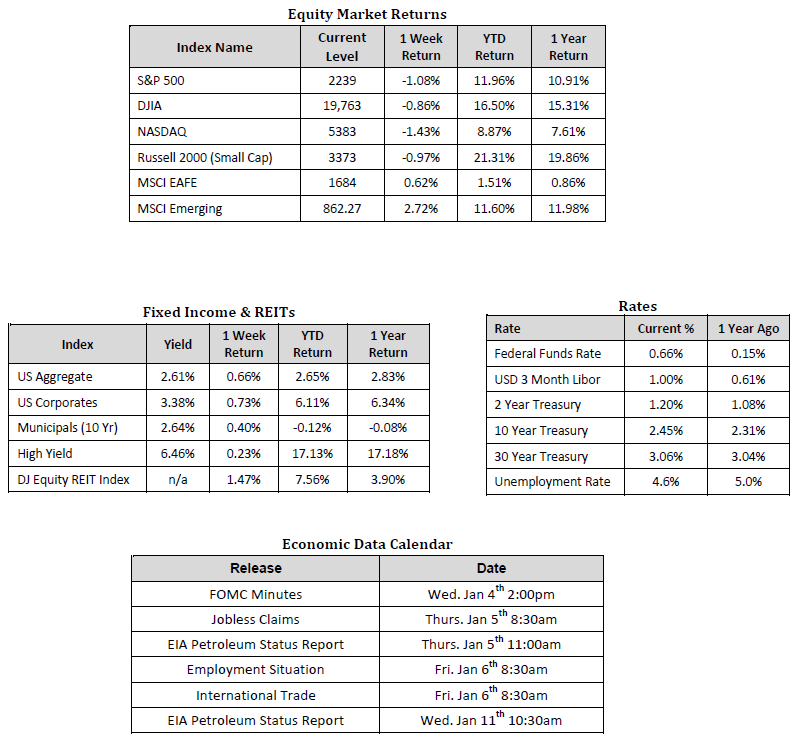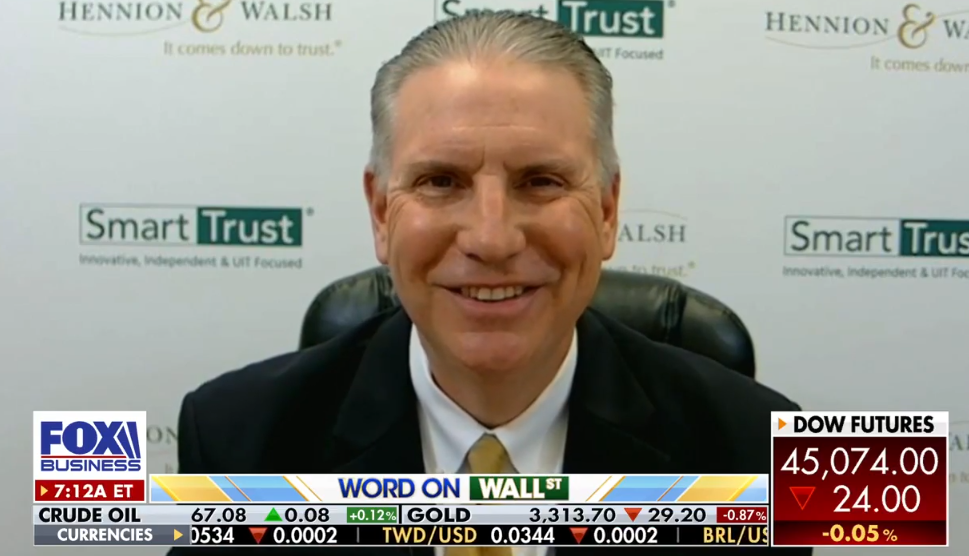
A Look Back at 2016 and Forward at 2017
Market Overview
Sources: Equity Market and Fixed Income returns are from JP Morgan as of 12/30/16. REIT, Rates and Economic Calendar Data from Bloomberg as of 1/03/16.
Happening Now
Happy New Year everyone! Domestic large cap stocks receded last week as evidenced by the S&P 500 Index losing 1.1% in the last trading week of 2016. Mid1 and small2 cap stocks also fell, each dropping approximately 1.0%. During the holiday shortened 4-day week, performance was broadly consistent across sectors with Real Estate posting the only gain (+1.3%) while Industrials, Materials, Energy, Consumer Discretionary, Technology, and Financials all lost between 1.2% – 1.4%. On the international equities front, developed3 and emerging4 markets ended the year strongly with gains of 0.6% and 2.7% respectively.
Two very different environments were exhibited during 2016. The first half of the year was marked by a risk-off sentiment as falling oil prices and a sharp downturn in stocks during the first two months were followed by concerns of an economic slowdown in China and the U.S. England’s surprise vote to leave the European Union (a.k.a. “Brexit”) served as an exclamation point to end the first half of the year as well as a turning point to start the second half. During the second half of the year “risk assets”, such as stocks and oil, rallied. This occurred despite heightened political uncertainty in the U.S. as well as an additional 0.25% rate hike by the Federal Reserve that was widely anticipated and eventually announced on December 14.
U.S. Stocks were once again the clear winner in 2016 with the S&P 500 Index ending with a 12% gain, mid1 cap stocks up 13.8% gain and small2 cap’s jumping 21.3% – all on a total return basis. Notable was the significant dispersion between value stocks and growth stocks. The Russell 1000 Value Index (+17.3%), which measures large cap value stocks, outperformed the Russell 1000 Growth Index (+7.1%) by over 10%. Sector dispersion was even more significant as the top three strongest performing sectors were Energy (+27.4%), Telecom (+23.5%), and Financials (+22.8%) while the bottom three performing sectors were Healthcare (-2.7%), Real Estate (+3.4%), and Consumer Staples (+5.4%). Developed international markets were unable to find the traction that U.S. markets did in 2016. For example, the MSCI EAFE Index, which measures the performance of developed markets, gained 1.5% (in USD terms) in 2016 with all of the gains attributed to the third quarter. Emerging markets survived a fourth quarter sell-off to end the year with an 11.6% gain (in USD terms) as measured by the MSCI EM Index.
As 2017 begins, we believe that there will continue to be great uncertainty and the potential for large swings in market prices. We expect investor sentiment to ebb and flow with announcements on President Trump’s legislative initiatives, reports on global economic growth, and ongoing geo-political risks in Europe and the Middle East. We also contend that while certain asset classes and sectors appear likely to outperform, investors need to ensure they have the diversification required to withstand intermittent bouts of market volatility. To this end, having a clear understanding of your long term goals can go a long way in aiding confidence and discipline.
The following indexes were used to represent asset class returns: 1Mid cap stocks- Russell Mid cap Index. 2Small Cap stocks – Russell 2000 Index. 3Developed markets – MSCI EAFE Index. 4Emerging Markets – MSCI EM Index.
Important Information and Disclaimers
Disclosures: Hennion & Walsh is the sponsor of SmartTrust® Unit Investment Trusts (UITs). For more information on SmartTrust® UITs, please visit www.smarttrustuit.com. The overview above is for informational purposes and is not an offer to sell or a solicitation of an offer to buy any SmartTrust® UITs. Investors should consider the Trust’s investment objective, risks, charges and expenses carefully before investing. The prospectus contains this and other information relevant to an investment in the Trust and investors should read the prospectus carefully before they invest.
Investing in foreign securities presents certain risks not associated with domestic investments, such as currency fluctuation, political and economic instability, and different accounting standards. This may result in greater share price volatility. These risks are heightened in emerging markets.
There are special risks associated with an investment in real estate, including credit risk, interest rate fluctuations and the impact of varied economic conditions. Distributions from REIT investments are taxed at the owner’s tax bracket.
The prices of small company and mid cap stocks are generally more volatile than large company stocks. They often involve higher risks because smaller companies may lack the management expertise, financial resources, product diversification and competitive strengths to endure adverse economic conditions.
Investing in commodities is not suitable for all investors. Exposure to the commodities markets may subject an investment to greater share price volatility than an investment in traditional equity or debt securities. Investments in commodities may be affected by changes in overall market movements, commodity index volatility, changes in interest rates or factors affecting a particular industry or commodity.
Products that invest in commodities may employ more complex strategies which may expose investors to additional risks.
Investing in fixed income securities involves certain risks such as market risk if sold prior to maturity and credit risk especially if investing in high yield bonds, which have lower ratings and are subject to greater volatility. All fixed income investments may be worth less than original cost upon redemption or maturity. Bond Prices fluctuate inversely to changes in interest rates. Therefore, a general rise in interest rates can result in the decline of the value of your investment.
Definitions
MSCI- EAFE: The Morgan Stanley Capital International Europe, Australasia and Far East Index, a free float-adjusted market capitalization index that is designed to measure developed-market equity performance, excluding the United States and Canada.
MSCI-Emerging Markets: The Morgan Stanley Capital International Emerging Market Index, is a free float-adjusted market capitalization index that is designed to measure the performance of global emerging markets of about 25 emerging economies.
Russell 3000: The Russell 3000 measures the performance of the 3000 largest US companies based on total market capitalization and represents about 98% of the investible US Equity market.
ML BOFA US Corp Mstr [Merill Lynch US Corporate Master]: The Merrill Lynch Corporate Master Market Index is a statistical composite tracking the performance of the entire US corporate bond market over time.
ML Muni Master [Merill Lynch US Corporate Master]: The Merrill Lynch Municipal Bond Master Index is a broad measure of the municipal fixed income market.
Investors cannot directly purchase any index.
LIBOR, London Interbank Offered Rate, is the rate of interest at which banks offer to lend money to one another in the wholesale money markets in London.
The Dow Jones Industrial Average is an unweighted index of 30 “blue-chip” industrial U.S. stocks.
The S&P Midcap 400 Index is a capitalization-weighted index measuring the performance of the mid-range sector of the U.S. stock market, and represents approximately 7% of the total market value of U.S. equities. Companies in the Index fall between S&P 500 Index and the S&P SmallCap 600 Index in size: between $1-4 billion.
DJ Equity REIT Index represents all publicly traded real estate investment trusts in the Dow Jones U.S. stock universe classified as Equity REITs according to the S&P Dow Jones Indices REIT Industry Classification Hierarchy. These companies are REITSs that primarily own and operate income-producing real estate.




